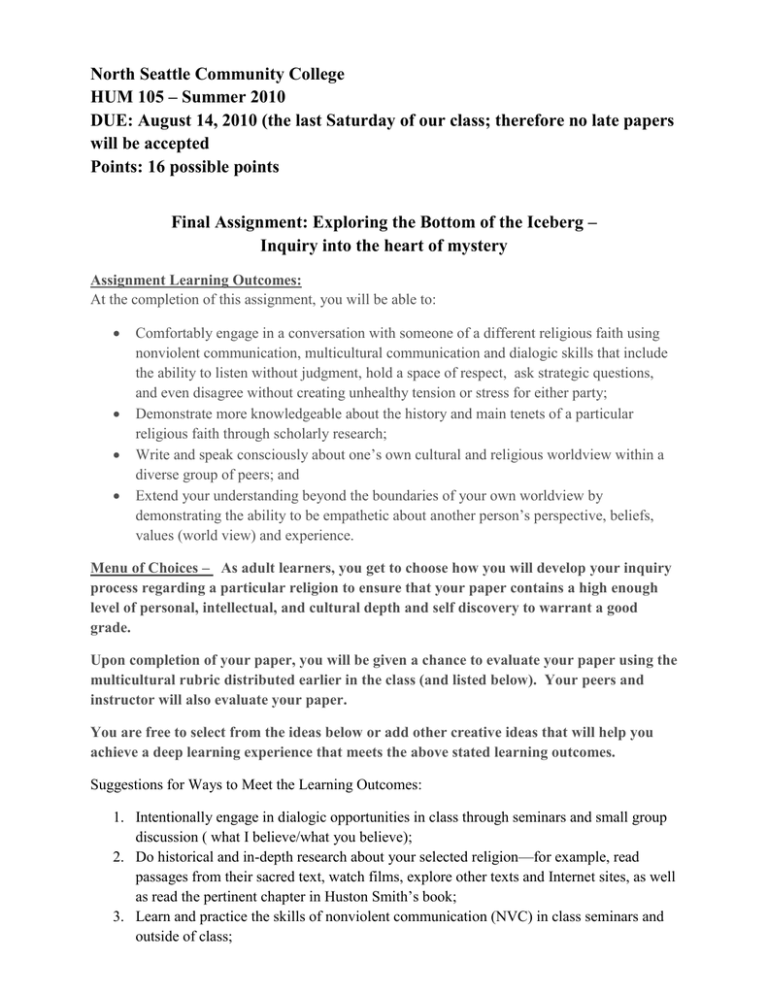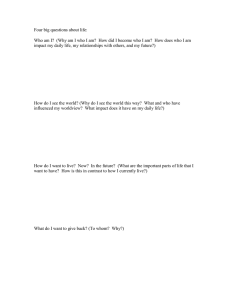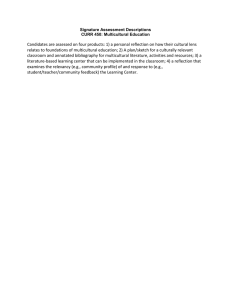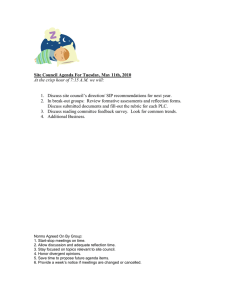North Seattle Community College HUM 105 – Summer 2010
advertisement

North Seattle Community College HUM 105 – Summer 2010 DUE: August 14, 2010 (the last Saturday of our class; therefore no late papers will be accepted Points: 16 possible points Final Assignment: Exploring the Bottom of the Iceberg – Inquiry into the heart of mystery Assignment Learning Outcomes: At the completion of this assignment, you will be able to: Comfortably engage in a conversation with someone of a different religious faith using nonviolent communication, multicultural communication and dialogic skills that include the ability to listen without judgment, hold a space of respect, ask strategic questions, and even disagree without creating unhealthy tension or stress for either party; Demonstrate more knowledgeable about the history and main tenets of a particular religious faith through scholarly research; Write and speak consciously about one’s own cultural and religious worldview within a diverse group of peers; and Extend your understanding beyond the boundaries of your own worldview by demonstrating the ability to be empathetic about another person’s perspective, beliefs, values (world view) and experience. Menu of Choices – As adult learners, you get to choose how you will develop your inquiry process regarding a particular religion to ensure that your paper contains a high enough level of personal, intellectual, and cultural depth and self discovery to warrant a good grade. Upon completion of your paper, you will be given a chance to evaluate your paper using the multicultural rubric distributed earlier in the class (and listed below). Your peers and instructor will also evaluate your paper. You are free to select from the ideas below or add other creative ideas that will help you achieve a deep learning experience that meets the above stated learning outcomes. Suggestions for Ways to Meet the Learning Outcomes: 1. Intentionally engage in dialogic opportunities in class through seminars and small group discussion ( what I believe/what you believe); 2. Do historical and in-depth research about your selected religion—for example, read passages from their sacred text, watch films, explore other texts and Internet sites, as well as read the pertinent chapter in Huston Smith’s book; 3. Learn and practice the skills of nonviolent communication (NVC) in class seminars and outside of class; 4. Through dialogue and conversation, intentionally put yourself in a position of discomfort in order to learn new communication skills that result in the development of empathy; 5. Personally interview someone who practices the faith you have selected to learn about; 6. Attend a religious service – temple, church or mosque; 7. Spend time alone and then with a partner intentionally reflecting on what you personally believe about existence of god, life after death, human’s relationship with the cosmos and the natural world, etc. in order to be able to communicate it effectively within a circle of diverse peers. Format: Write a Critical Research and Reflection paper on a particular religion that you choose to explore. Your paper should be written in narrative form and include the following three sections: 1. Selected Religion – Research and Findings This section should include a critical reflection of what you learned about the religion you studied. Choose to focus on several elements to discuss that “blew your mind” as you studied and learned about this particular faith that was in dramatic contrast to what you believe. Include quotes to support your statements. 2. My Own Worldview This section provides an opportunity to explore your own thinking in contrast to what you studied and researched. What questions arose for you as you did your research about your own beliefs – where they came from, perhaps the development of your own spiritual or religious practices beyond what you were taught as a child. In other words, what do you believe to be true for you that is now clearer as a result of your research and study? 3. Evidence of New Multicultural Skills as a “Global Citizen” This section is an opportunity for you to review what we have discussed, read, and been in dialogue about in this class. You should take time to go back over your notes, the various texts, and handouts. Where has been your greatest growing edge? Did nonviolent communication take you to a new place of learning? What about the section of privilege and agency/target? Isaacs’ piece on dialogic leadership? The videos – Elif Shafak or Chimamanda Adichie? How have you grown as a multicultural communicator – what skills, new knowledge and attitudes do you have that you didn’t have coming into this class? How has this new learning prepared you to participate in the world in a different way? Support your writing with evidence. Correct MLA citation required. No more than 5 pages. Double spaced. Include a Works Cited page. 16 points possible (see rubric below) Evaluation Rubric – 4 Elements of Intercultural Communication Competency 1. Skills: Empathy (1-4) Interprets intercultural experience from the perspectives of own and more than one worldview and demonstrates ability to act in a supportive manner that recognizes the feelings of another cultural group. Possible Sources of Evidence: cultural/religious conversations in or out of class, attending a religious service, temple, mosque, etc., concluding reflection 2. Skills: Verbal and nonverbal communication (1-4) Articulates a complex understanding of cultural differences in verbal and nonverbal communication (e.g., demonstrates understanding of the degree to which people use physical contact while communicating in different cultures or use direct/indirect and explicit/implicit meanings) and is able to skillfully negotiate a shared understanding based on those differences. Possible Sources of Evidence: reassessment of two surveys; concluding reflection 3. Knowledge: Knowledge of cultural worldview frameworks (1-4) Demonstrates sophisticated understanding of the complexity of elements important to members of another culture in relation to its history, values, politics, communication styles, economy, or beliefs and practices. Possible Sources of Evidence: Religious Inquiry including reading a chapter and including selected quotes from Huston Smith’s book, viewing videos, doing Internet research, reading and reflecting on key passages from sacred text 4. Knowledge: Cultural self- awareness (1-4) Articulates insights into own cultural rules and biases (e.g. seeking complexity; aware of how her/his experiences have shaped these rules, and how to recognize and respond to cultural biases, resulting in a shift in self-description.) Possible Sources of Evidence: Personal Worldview Reflection – see sample questions below



